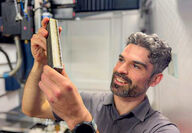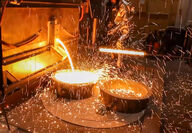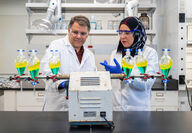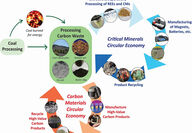Sorted by date Results 1 - 25 of 93

New alloy eliminates vanadium, boosts strength, and improves print quality. Pushing the boundaries of additive manufacturing, engineers at Royal Melbourne Institute of Technology (RMIT) University have developed a new 3D-printable titanium alloy that is 29% cheaper to produce than aerospace-grade titanium, offering a leap forward in performance, ductility, and cost-efficiency by eliminating reliance on increasingly expensive vanadium. Valued for its high strength-to-weight... Full story

Lithium phosphate, iron-sodium, and organic flow batteries are headed to critical infrastructure sites. When the grid goes down, so can the interconnected systems of water treatment plants, health centers, emergency services. To bridge those critical gaps, the U.S. Department of Energy is investing in a trio of next-generation energy storage technologies that could help safeguard vital infrastructure. To keep critical infrastructure running through the next blackout, the U.S....

Supports Indian technology advances, decarbonization, and materials security. As India accelerates on its path toward mineral security and a low-carbon future, Vedanta – one of the world's leading natural resources companies – has announced a bold move up the value chain, positioning itself not just as a supplier of raw materials but as a catalyst for industrial transformation. Driven by the rising demand for refined, high-performance metals, the boundary between resource ext...

Researchers alter atomic structure of cerium to emit visible light. In a discovery that challenges long-held assumptions about the behavior of rare earth elements, scientists have taught cerium – a metal best known for its invisible ultraviolet glow – to shine visibly yellow by reshaping the chemical environment around its atoms, opening a new frontier in how these elements can be coaxed into revealing capabilities hidden within their makeup. Critical to nearly every fac... Full story

Japan builds first diamond transistor for extreme conditions. In a breakthrough that could redefine the future of electronics in extreme environments, scientists in Japan have created the world's first diamond-based transistor capable of operating at high temperatures – opening the door to ultra-efficient chips that can handle intense heat and radiation where traditional silicon fails. Long prized for their beauty and durability, diamonds are quickly becoming a scientist's b...

How the new wave of robotics is driving demand for critical minerals. AI-driven robotics are poised to transform industries like manufacturing, healthcare, and logistics, ushering in a new era of efficiency, autonomy, and safety. But behind the sleek machines is a story of material intensity. Whether it's a humanoid on an assembly line or a robodog on the beat, every robot depends on high-performance materials: lithium-ion batteries for power, rare earth magnets for motion,...

Boston Metal succeeds with first full-scale test of electric furnace. Marking a turning point for emissions-free steel, Boston Electrometallurgical Corp. has for the first time operated its unique electricity-powered furnace at industrial scale, proving the company can produce molten iron without coal or carbon emissions – a breakthrough that not only validates the technology but also paves the way for cleaner, more sustainable steel production worldwide. Fundamental to c...

Executive order calls for removing roadblocks and directing billions to domestic supply chains. The "Immediate Measures to Increase American Mineral Production" executive order signed by President Donald Trump on March 20 puts the weight of the federal government behind reducing the United States' heavy reliance on mineral imports. This White House directive comes at a time when global supplies of minerals critical to the U.S. economy and security are threatened by...

New shape-memory alloy maintains strength and flexibility across an unprecedented temperature range. Scientists at Tohoku University, Japan, have unveiled a revolutionary titanium-aluminum-chromium (superelastic shape-memory alloy that maintains its strength and flexibility across temperatures from the frigid depths of liquid helium (minus 269 degrees Celsius) to heat beyond boiling water (127 degrees Celsius). This material, which combines lightweight durability with extreme...

New NMPP Report outlines strategies to counter disruptions in critical mineral markets, secure supply chains, and advance sustainability. In a landmark initiative to bolster transparency and sustainability in critical mineral markets, a joint report from the U.S. Department of Commerce and the Norwegian Ministry of Trade, Industry, and Fisheries examines the disruptive effects of non-market policies and practices, with a particular focus on vulnerabilities in the supply...

Experts urge Congress to take bold steps to secure America's mineral independence. With China dominating the supply of minerals critical to America's economy and security, Washington policymakers are seeking policy solutions to reinvigorate the domestic mining sector. A recent U.S. House Natural Resources Committee hearing, titled "Now Ore Never: The Importance of Domestic Mining for U.S. National Security," brought experts together to provide insights into the nation's...

Backed by $28.5 million in federal funding, Missouri S&T's Tech Hub is positioned to transform the U.S. critical minerals supply chain. From pioneering innovative techniques for recovering rare metals from mining waste to shaping the next generation of battery materials and sustainable mining practices, Missouri University of Science and Technology (Missouri S&T) is solidifying its reputation as a national leader in critical minerals research with the recent announcement of...

Invests $45 million for regional Carbon Ore, Rare Earth and Critical Minerals (CORE-CM) assessment across the nation. To help break America's reliance on imports for many of the minerals critical to the nation's economy and security, the U.S. Department of Energy is investing $45 million into six regional projects from Alaska and the Pacific Northwest to the Appalachian Mountain region near the Atlantic coast. "Rebuilding a domestic supply chain for critical minerals and...

Energy Fuels sets high standards, to remove 10,000 tons of uranium-bearing cleanup materials from abandoned mines at no cost. In a historic collaboration toward reconciliation and environmental stewardship, Energy Fuels Inc. and the Navajo Nation have signed an agreement to safely transport uranium ore and tackle the legacy of abandoned uranium mines that have marred tribal lands for decades. "The Navajo Nation has suffered longstanding impacts from uranium mining conducted...

From space tech-enabled copper exploration in Australia to nuclear fuel made in America, MTN counts down the most popular articles of 2024. Over the past year, Metal Tech News writers delivered more than 500 articles with deep insights into the scientific breakthroughs, mining initiatives, government policies, and market conditions that are shaping the future for technology metals and mining technologies. These articles took readers from material science discoveries in the... Full story

$17M in funding supports innovation to bolster domestic resource recovery. To address vulnerabilities in the global supply chain for critical materials, the U.S. Department of Energy is awarding $17 million for 14 projects aimed at advancing domestic production and recovery of essential resources needed for next-generation technologies. Rising geopolitical tensions and tightening trade policies have exposed the fragility of global supply chains for critical materials such as...

Texas researchers know how to handle heat, boosting cooling by 72%. Few topics among PC enthusiasts spark as much heated debate – literally and figuratively – as the humble thermal paste. Ask any tech head about the ideal amount or application pattern, and you'll likely get a different answer every time. Now, material scientists may have flipped the script with an industry-changing thermal compound boasting unprecedented cooling potential – sorry gamers, it's designed for d...

Researchers merge light and sound on microchips, unlocking a new frontier in data processing, sensing, and communication. Microchips have always relied on electricity to process data, but what if they could harness sound instead? In a groundbreaking twist, researchers have managed to confine high-frequency sound waves to a chip's surface that ripple like a miniature earthquake – an unexpected breakthrough that could redefine everything from data processing to advanced sensing,...

Combining AI with LP-LIBS, DTE's aluminum analysis cuts energy use and boosts efficiency. In the face of surging global demand for aluminum and rising energy costs, an Icelandic company is pioneering a new solution with its real-time melt analysis technology that promises to revolutionize aluminum production by providing immediate insights into molten metal composition, significantly cutting down on energy usage and production times while ensuring higher efficiency and...

Funding supports 16 projects to advance safety and licensing of HALEU for nuclear reactors. Capitalizing on the now unlocked $2.7 billion to secure a domestic nuclear fuel supply, DOE has awarded $17 million to 16 projects aimed at criticality benchmarking for high-assay low-enriched uranium (HALEU). These projects, essential for advancing next-generation nuclear reactors, will provide the U.S. Nuclear Regulatory Commission (NRC) with the data needed to accelerate HALEU licens...

Russian uranium import ban ripples through clean energy sector. With the clock running down on uranium stockpiles, the U.S. faces an urgent need to secure its energy future. New legislation and significant investments are set to revive domestic production of this zero-carbon energy fuel, reduce reliance on foreign imports, and bolster national security –measures that aim to ensure a stable uranium supply for nuclear energy as the country races to meet its demands. In May 2...

Will the controversial metal find its place in green tech? About 30 years ago, nobody thought much about cobalt. Today, this metal, with myriads of uses, is one of those elements that gets dragged into the spotlight due to the role it plays in electric vehicle batteries, with critics citing the disparity between the environmental and social costs of producing cobalt and the green tech solutions this critical metal enables. But we can't build a clean energy future without...

New study upends what scientists thought they knew about why gallium melts in your hand. As a metal that turns to liquid at near room temperature and has the uncanny ability to take on the catalytic properties of other metals, gallium is an enigmatic element that intrigues material scientists. The understanding of why gallium melts at 85.6 degrees Fahrenheit (29.8 degrees Celsius), however, may have been built on a foundation as solid as this strange metal during the midday... Full story

Funding to support additional research in extracting rare earth elements from coal byproducts, enhancing sustainability and domestic supply. As part of ongoing efforts to bolster domestic supplies of critical minerals, the U.S. Department of Energy's Office of Fossil Energy and Carbon Management has announced an additional $10 million investment aimed at lowering costs and reducing the environmental impact of producing rare earth elements and other critical minerals from coal...

The United States and China are battling to secure stakes in copper mines around the world, and the stakes have never been higher. In a clash of titans, America and its free-market economy values compete against the Asian superpower with its stranglehold on copper resources and processing. With copper, the "red metal" critical to America's clean energy future, it's time to focus on developing domestic assets and amping up the country's process engineering. "We are in a second... Full story